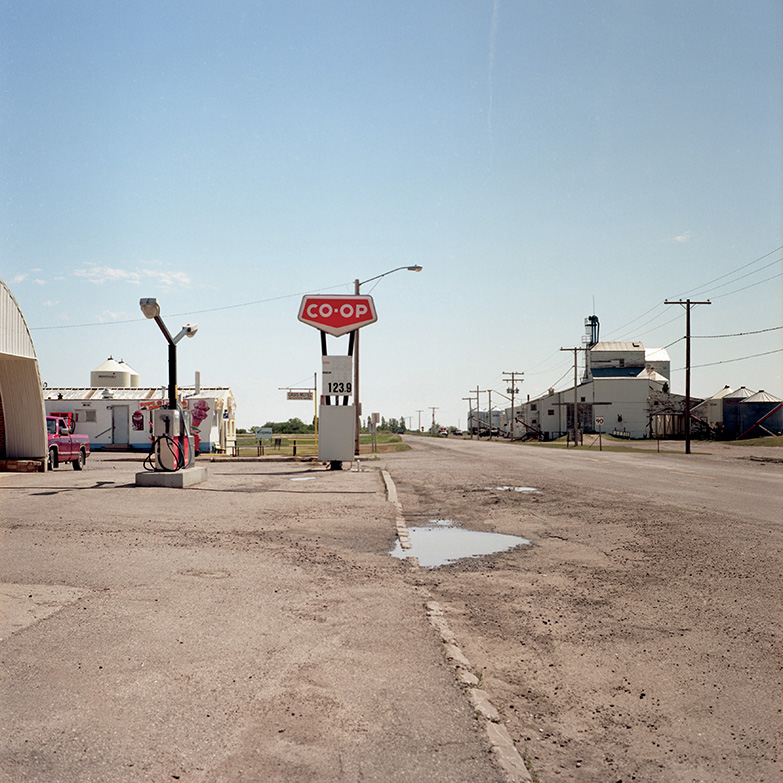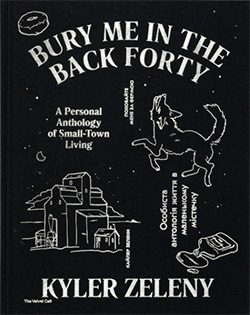2024 – Kyler Zeleny: Bury Me in the Back Forty
“These are not the backward folk of too-common urban myths,” Kyler Zeleny wrote for The Globe and Mail, “These are people in pain.”
He continues:
These are people who, having seen public services slashed to the bone, defend their own properties, knowing that the police will take at least 20 minutes to respond. These are people who know that, unlike [in] cities, there is no promise of redevelopment in small towns…. These are people who are seeing their way of life become endangered but who also proudly remember that their economies were once among the most competitive in Confederation…. These are people losing hope, buffeted by U.S. influence from the south, disdain from the east and indifference from urban neighbours — all of which threatens to push Prairie dwellers into political retreat, division and radicalization. (1)
Raised in a small town in central Alberta, Zeleny speaks from experience. He describes his personal history succinctly:
From a young age I was interested in those abandoned farmhouses, the old country halls and schools. When I was sixteen my friend and I would go at night and explore them with the glow of our phones (phones that didn’t yet have flashlights attached to them). I was terrible with a camera then; it was pure documentary but poor photography….
Years ago, as many do, I left the Prairies – left my home in Mundare, Alta., in search of opportunity in places such as London and Toronto. But the Prairies are in my bones.
It was this sense of his own roots that led him back to the Prairies, and to the making of the three books that comprise The Prairie Trilogy: Out West, 2014; Crown Ditch and the Prairie Castle, 2020; and Bury Me in the Back Forty, 2024. While Bury Me in the Back Forty is the most complex of the three, it’s worth following the progression of Zeleny’s thinking right from the start of the trilogy: he is one of only a few Canadian image-makers who have chosen the prairie lands as a primary subject.
Zeleny describes Out West as “a visual travelogue”, noting that it represents more than a hundred communities ranging in population from six to nearly a thousand. “The project offers a version of the current state of affairs in the Canadian West,” he writes, “exploring how rural spaces experience an urban-rural time lag. The images conjure up a Vonnegut-like idea of being “unstuck in time”, where objects and the built landscape can deceive the viewer as to the period [in which] they belong.”
Section-sewn with a card cover, the book is beautifully designed and straightforwardly photographed. The images are square, primarily frontal in perspective and center-weighted; in formal terms they recall the work of the New Topographics photographers who have explored similar terrain, particularly Joe Deal and Frank Gohlke. But while there is a studied neutrality, even a coolness, in the photographs of both Deal and Gohlke —and by extension, in all the work associated with the New Topographics aesthetic — Out West exudes a warmth that derives not just from clear air and prairie sunlight, but also from Zeleny’s keen sense of pastness existing in present time, which is something very different from either objectivity or nostalgia.

Crown Ditch and the Prairie Castle builds on this sense of pastness, but with increased emphasis on the tensions of the present. It has a more varied layout and includes triptychs, foldouts and text inserts; the photographs are no longer uniformly square in format, and some run across the gutter. And there is a much greater focus on individual people: it is their faces and body language which add a restive, unsettled edge to the book.
Zeleny explains:
The area was settled by a unique brand of hardened frontiersmen—cowboys, ranch hands, miners, farmers, and outlaws—the dirty and determined… chasing the exalted allure of a grand landscape defined by its apparent nothingness….
Gone are the early remnants of the Canadian prairie but its legacy still endures. Crown Ditch and the Prairie Castle documents the spaces and people of the last great ‘proving out’.
This is certainly true: Zeleny’s subjects ask nothing from the viewer except to be seen as they are. And although Zeleny’s way of photographing the landscape initially seems unchanged, there are differences of scale in this newer project, and more attention to the horizon, especially in the triptych images. Some of these evoke landscapes Thaddeus Holownia made with a wide-field banquet camera, and Zeleny’s way of photographing also carries echoes of Magnum photographer Kryn Taconis’ prairie images from nearly two generations ago. There are even occasional traces of the kind of appreciative, almost loving, irony that Henri Robideau used so effectively during his Canadian travels, and all of this serves to enrich Zeleny’s work. (2)

These two books effectively set the stage for Bury Me in the Back Forty, which concludes the Prairie Trilogy by documenting Mundare, Alberta itself. This was once Zeleny’s home, a place he describes as “a seemingly typical rural community of just over [nine hundred]. …Through photographs, collected objects, community archives, audio recordings, oral histories, and sketches,” he adds, “the idea of a prairie town in performed.”
The concept of visual performance is intriguing, but the performative aspects of the book are more fundamentally the result of its careful construction: Bury Me in the Back Forty is built in layers, from the ground up and from the past to the present.
Four unpeopled landscapes, defined in scale by single wooden utility poles, serve as metaphorical tent stakes for the entire project. Printed as two-page spreads, each is interrupted by the insertion of a small pink sheet of paper into the gutter. Typewritten on one side is commentary, apparently from letters to Zeleny from an unnamed “friend and prairie spirit”; entered on the verso are GPS coordinates, also typewritten, followed by the descriptive words “WATER”, “RAILS”, “DIRT”, and “(RANGE) ROADS”. By entering the coordinates, you can pinpoint these landscapes.
The primary, essentially the ground-level layer of the book, however, is taken from the pages of a 1980 community history, whose Table of Contents lists ten chapters and nearly 200 pages. The text that Zeleny has left visible offers a fragmented narrative of the settlement, farming and development of the Mundare region, peopled largely but by no means exclusively by individuals and families who emigrated from Ukraine.
On top of this text (which itself contains photographs) are historical images Zeleny has collected. Sometimes these are shown intact; sometimes they are damaged, redacted, written upon, or defaced; sometimes they are digitally altered, in ways that can be eerie or even shocking. The themes are what you would expect: hard work, hope and disappointment; births, deaths, tragedies and celebrations; families, schooling, religion; some play, hard winters, fires; planted fields, dirt roads, snow. As far as I can tell, these photographs cover nearly two-thirds of the last century, from the late 1920s to sometime in the 1980s.
Closest to us in time are Zeleny’s own photographs, which serve to re-frame the interleaved records of text and image described above, and to form the topmost, temporal layer of the work. These photographs are completely of and about the present — an abandoned meeting hall, a woman squinting against the sun, an owl staring down from a tree, frozen by camera flash — yet completely congruent with the past.
The book can be read front to back or back to front or from the middle out; it can be glanced at, stared at, studied, put aside, gone back to; you can look at the photographs and ignore the text; you can focus beyond the edges of the photographs and try to piece together the text; you can skip-read, you can not bother to read. You will always find something: the book has the spontaneity of a patchwork quilt and the logic and rigor of a dissertation. Most important of all, it’s vivid: plain, simple, human, and right in front of you.

As I was writing this, Zeleny emailed with some comments and observations, parts of which I’d like to use as a postscript:
The gravel roads where these country structures once thrived are now empty, a lonely and dark landscape, giving one the sense of ownership by virtue of presence alone. It is so quiet you forget people call these places home. We threw molotov cocktails on gravel roads and searched out places to make our own…. Killing time, smashing cans, burning light and postponing boredom. These places exist all over the prairies, some well-hidden and others in plain sight with names like Ranfurly, Dead End and Cavalier…. As Susan Sontag told us about the rag-picker and Wallace Stegner about garbage piles, these are not sites to ignore, this is where history can be found in the present.

All photographs: Kyler Zeleny
For more on Kyler Zeleny’s work, see https://kylerzeleny.com/
(1) From We Live in the Prairies. Will You See Us? The Globe and Mail, September 4, 2020
(2) For more information on Robideau, see http://henrirobideau.com

